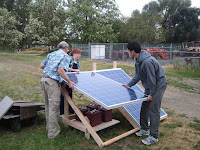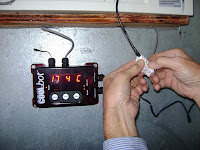19 April 2012
 Hello everybody. We are Bradley, Jasmine and Majid and we are working with Zamorano University to design a process for making large quantities of BioChar. BioChar is the result of burning highly compressed agricultural waste under low oxygen conditions in a process known as gasification. It resembles Kingsford charcoal briquettes in size, appearance and density. Farmers can potentially use it as a soil additive to trap nutrients needed by crops or it can be burned like regular charcoal to cook food or produce high temperature heating. However, to understand if BioChar can excel at either of these uses, many different manufacturing processes and agricultural waste mixtures need to be tested out. This is where our UC Davis D-Lab team comes in. Over the next ten weeks, we will be designing processes and machines to grind up agricultural wasted into fine particles and compress them into a dense mass ideal for the gasification process. This will help Zamorano University thorougly test BioChar and determine whether it is a suitable product for farmers. In the future, they can use our initial designs as a prototype for a machine that will help farmers produce their own BioChar. As Professor Tim Longwell, our mentor from Zamorano University explained, "BioChar is an excellent product that can be used to increase cation exchange capacity in soils to increase yields."
Hello everybody. We are Bradley, Jasmine and Majid and we are working with Zamorano University to design a process for making large quantities of BioChar. BioChar is the result of burning highly compressed agricultural waste under low oxygen conditions in a process known as gasification. It resembles Kingsford charcoal briquettes in size, appearance and density. Farmers can potentially use it as a soil additive to trap nutrients needed by crops or it can be burned like regular charcoal to cook food or produce high temperature heating. However, to understand if BioChar can excel at either of these uses, many different manufacturing processes and agricultural waste mixtures need to be tested out. This is where our UC Davis D-Lab team comes in. Over the next ten weeks, we will be designing processes and machines to grind up agricultural wasted into fine particles and compress them into a dense mass ideal for the gasification process. This will help Zamorano University thorougly test BioChar and determine whether it is a suitable product for farmers. In the future, they can use our initial designs as a prototype for a machine that will help farmers produce their own BioChar. As Professor Tim Longwell, our mentor from Zamorano University explained, "BioChar is an excellent product that can be used to increase cation exchange capacity in soils to increase yields."
The Grass Hits the Fan
2 May 2012 Today, we foraged for switchgrass, pine needles and blenders, scouring places like the Plant and Environmental Sciences garden and local thrift stores in our search. Specifically, we were looking for materials to test out our earliest design concepts. Our ideas though still vague, consisted of using a shredder or blender to reduce the grass to small particles. For compression, a car jack or hand press may work.
Today, we foraged for switchgrass, pine needles and blenders, scouring places like the Plant and Environmental Sciences garden and local thrift stores in our search. Specifically, we were looking for materials to test out our earliest design concepts. Our ideas though still vague, consisted of using a shredder or blender to reduce the grass to small particles. For compression, a car jack or hand press may work.The blender fared rather well by comparison. We shoved a fistful of grass into the glass bowl, clamped down the lid and put it on the highest speed. Eventually, a fine powder formed at the bottom of the bowl. Large pieces of grass still remained at the top, but that didn't dampen our spirits. This idea could work. Brad was also successful in destroying all evidence that he had put grass in his wife's blender.
Shopping
8 May 2012
 Today is our first build session. By now, we've narrowed down our ideas to a blender to grind up the grass into particles and an extruder to compress it (check out Wikipedia for details on how the extruder works and what it looks like). We need to test different blender designs to reduce the size of the final grass particles and we have not tested an extruder of any kind yet. We decide to head over to ACE Hardware to get some materials to build and test out the ideas. The blenders at ACE are somewhat disappointing: most of the blades are fastened with rivets. This means we can't easily remove the blade and attach our own.
Today is our first build session. By now, we've narrowed down our ideas to a blender to grind up the grass into particles and an extruder to compress it (check out Wikipedia for details on how the extruder works and what it looks like). We need to test different blender designs to reduce the size of the final grass particles and we have not tested an extruder of any kind yet. We decide to head over to ACE Hardware to get some materials to build and test out the ideas. The blenders at ACE are somewhat disappointing: most of the blades are fastened with rivets. This means we can't easily remove the blade and attach our own.Target has over 15 different models of blender including the accurately named Oster Glass Jar Blender (TM, R) and the not-so-accurately named Ninja Personal Blender (TM, R). Unfortunately all of the designs suffered from the same problems as the ones at ACE: improbably strange blade mountings. We finally come to the conclusion that it would be best to build our own blender so that we can test multiple blade designs. We end up purchasing a plastic cylindrical trash can to be the blender bowl, some sheet metal to make blades from, and a meat grinder (essentially an extruder for ground beef).
We don't need no false control
10 May 2012
We begin to fashion blades from the sheet metal, but don't finish anything in time to test. The testing of the meat grinder, however, progressed much more rapidly. We chopped up some grass with a blender, lubricated it with water and stuffed it into the meat grinder. We started to turn the crank, but at some point we must have applied too much force to the handle because it broke off.
The question now is what to do with the remains of the meat grinder? Do we cleanse all traces of grass from it and discreetly try to return it to Ace Hardware, making no mention of our disregard for its intended use? Do we repair it and try to make ground beef? Or maybe we could make a modern art sculpture out of it?
Extrudinary Success!
17 May 2012
 It worked! Garry from the Thailand Coolbox project loaned us his oil press (an extruder for squeezing oil out of peanuts and sunflower seeds). It successfully compressed the grass into a mass so dense its gravitational field could be measured by a fat man on a scale in Switzerland. Errr, I mean, so dense, we couldn't get it out of the die. It looks like the extruder will be our choice for compression
It worked! Garry from the Thailand Coolbox project loaned us his oil press (an extruder for squeezing oil out of peanuts and sunflower seeds). It successfully compressed the grass into a mass so dense its gravitational field could be measured by a fat man on a scale in Switzerland. Errr, I mean, so dense, we couldn't get it out of the die. It looks like the extruder will be our choice for compression












